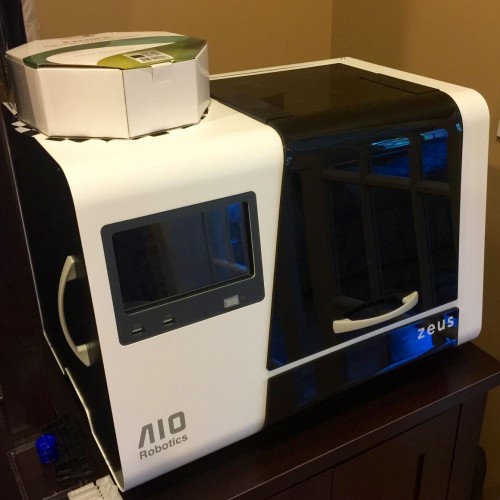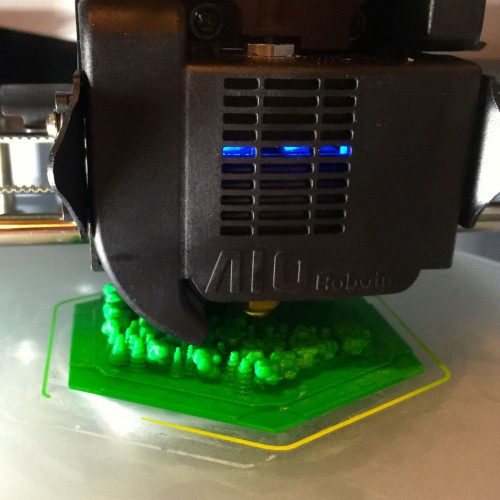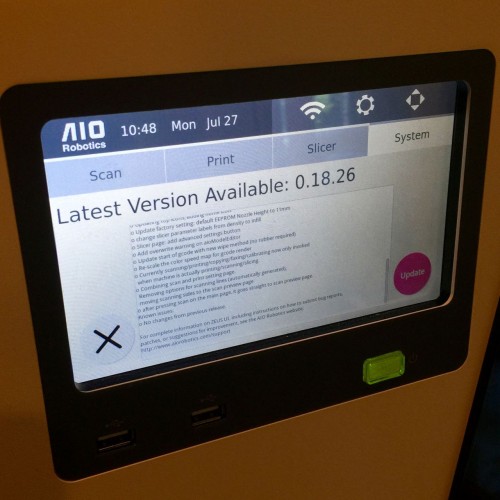3D printing is stuck firmly in the hobbyist world: It’s overly expensive, not at all practical, produces items of limited utility, and requires far too much time and effort. Yet it’s also so utterly transformative that the experience is other-worldly. Other-timely, really, since it’s obvious that this is how many daily objects will be produced in just a few years.

My 3D Printer: AIO Robotics Zeus
Way back in 2013 I decided to buy a 3D printer. I picked a brand new one on Kickstarter, the AIO Robotics Zeus, because I believed the team could deliver and that it would advance 3D printing from the tinkerer level (most earlier models were about as user-friendly as an Arduino) to the hobbyist realm (more like a Raspberry Pi). After a year of predictable delays, my printer was delivered in December and I’ve been playing with it ever since.
The Zeus is a true all-in-one device in two important ways:
- It prints and scans with no reconfiguration. Although there are other printers with a scanner option, most require substantial effort when switching from one mode to the other. It also copies and “faxes” (sending models over the Internet to other Zeus printers).
- It includes an embedded touch screen computer for truly standalone operation. Because 3D printing takes hours, it’s good to have a dedicated, purpose-built computer running the whole operation rather than tying up your computer and risking your model after 4 hours when Windows updates itself.
Although this combination seemed a bit aggressive for a Kickstarter project, I decided the AIO Robotics team was up to the challenge after reviewing their design: Most of the tricky bits of the Zeus are open source and off-the-shelf, including the printing and scanning software, and the design is fairly straightforward.

The only truly custom part of the Zeus is their “Thunderbolt” extruder. This is the heart of any printer, and the fact that they were designing and manufacturing their own gave me pause. But my faith was rewarded and the extruder has proven extremely capable. In fact, this could be the most valuable piece of IP the team has developed!
In practice, the Zeus prints quite well but falls well short in scanning. It maintains a library of printable objects internally and printing is both simple and predictable. The chassis is solid, with thick guide bars and a sturdy shell, and the only printing failures I’ve experienced were due to faulty designs or cracked filament.
Scanning is another story. Although some scans have worked out perfectly, most are useless, with extraneous “ghost blobs” appearing inside and outside the object in question. But AIO Robotics has consistently released software updates and scanning is improving markedly.

I have had a few issues, however. First, a too-soft adhesive was used to attach the removable glass turntable to its base, and this has come loose for me and a few others. I superglued it back together and it seems to be holding up. Also, the team is nearly absent from their own forums1 and hasn’t communicated with us owners at all since delivery. They seem still to be working, delivering software updates and news posts, but I’d like a lot more interaction as an early adopter!
Overall, I’m happy with the AIO Robotics Zeus printer. It is as functional and user-friendly as such a device could be at this point. So let’s step back and consider the category.
You Can’t Print That…
As a category, 3D printers are remarkably limited. Given the “maker” hype, and what I’m going to say in the next section, I think a massive reality check is in order!
Here’s what you truly can’t do with a 3D printer:
- Objects don’t magically appear – Buying a laser printer doesn’t mean you can immediately have the next great novel in your hands, and buying a 3D printer doesn’t mean you life will instantly be populated with cool toys. You have to create before you can print, or find someone else to create for you. This is non-trivial and time-consuming, even with excellent tools like Tinkercad and Thingiverse at your disposal.
- Very few things can be 3D printed – There are massive limitations to PLA extruder printers like the Zeus or Makerbot. PLA isn’t that tough or durable, so you can’t make anything really rugged. And extruders need support while printing, so you must be very careful and keep printability in mind when designing objects. You can make models, cases, brackets, and so on but not much else without using a totally different kind of printer.
- 3D printing is not economical – 3D printers and PLA filament aren’t out of reach for many people (expect to pay $1k-$2k) but the final cost of printed goods is not cost-competitive with other production methods. Divide the investment by the number of printed items and you’re looking at some very expensive figurines and vases! And printing is too slow to make up the cost in volume. 3D printing is a prototyping tool and a toy for first-worlders and nothing more.
- It takes a long time to print – 3D printing sounds like a killer way to produce a vast assortment of objects on-demand, but the technology is way too slow for that right now. Yes, you could take a self-contained printer like the Zeus to a craft show and print stuff, but you’d only be able to make a few objects before closing time2.
- 3D printed objects are small, rough, and inelegant – If you’re making a computer case or a mounting bracket you’re probably happy with what comes out of a 3D printer, but most people would want a slicker product. Even at high resolution (which takes much longer) it will be obvious it came from a 3D printer. And you can’t print a new paddle for your kayak or anything else larger than would fit in a breadbox.
All of these limitations will disappear eventually. But right now they keep 3D printing (especially PLA extruder printing) solidly in the realm of “gee whiz”.
Pondering the Implications of 3D Printer
Despite the limitations I just mentioned, I remain bullish on the concept of 3D printing. And it all boils down to a simple fact: It is simply mind-blowing to go from idea to physical object without leaving your desk!
So many of us spend our days sitting in front of a computer, interacting with virtual objects and virtual people, yet we yearn for physical reality. We want to be able to touch what we see, but we never can. 3D printing changes that, putting virtual objects into our hands. And this is transformative in a way that few other technologies have been.
Think of something you’d like to have3. If it can be 3D printed, you can probably design it in Tinkercad, download it to your computer or printer, print it, and have it in a few hours. And you can take pleasure knowing that it’s yours, that it’s unique, and that it’s exactly what you wanted.
This joy of creation isn’t well-known in the digital arena. Sure, some programmers feel it. But most computer users are just interacting, not creating. 3D printing brings us back to our roots as tinkers and crafters. It lets us know how it felt to be a furniture or watch maker, to build something and have it be ours. It’s a high-tech jackknife or hunk of clay.
And someday 3D printing will be much more. PLA extruders only get us so far, but there are many other kinds of 3D printers being developed. You can already craft objects out of metal, ceramic, and even chocolate! And CNC machining (really industrial 3D printing) is already a mainstay of modern factories. After witnessing one of these devices in action, it’s clear that this is the future.
Stephen’s Stance
Although I enjoy my AIO Robotics Zeus 3D printer, I’m under no illusions that it’s an economical or practical device. It’s a toy that takes me into the future, and I love being there!
Leave a Reply